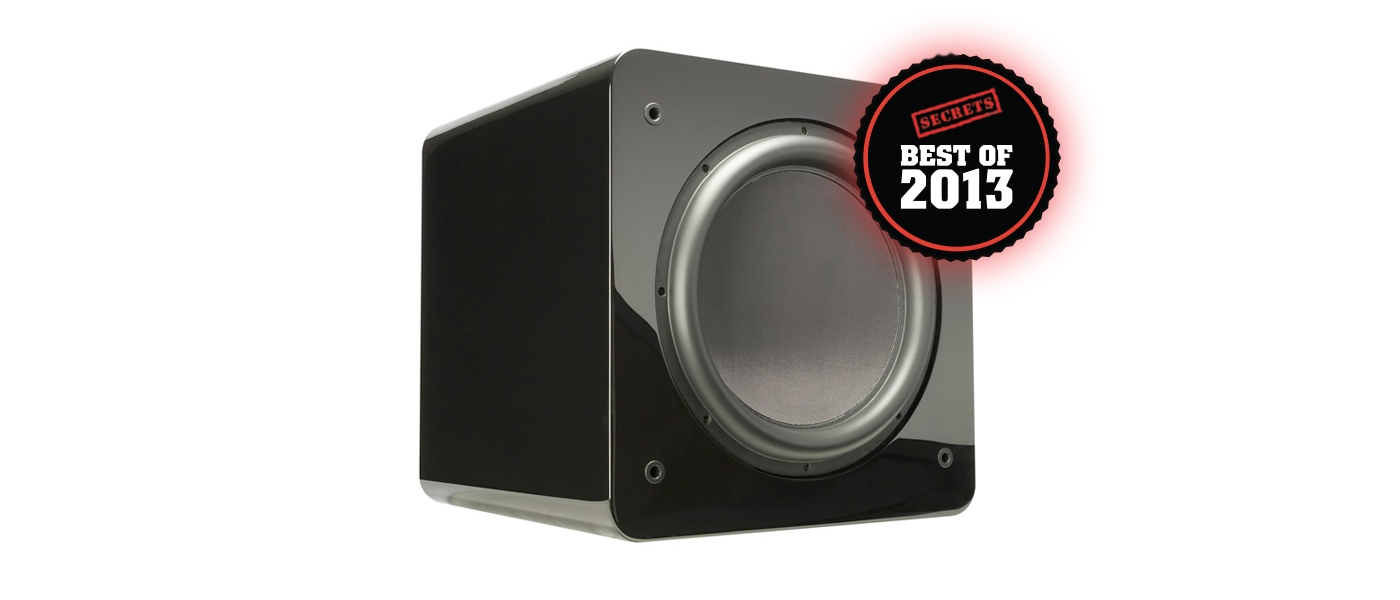
Introduction to the Triad Gold Monitors and Silver Subwoofer
Last year, I had a chance to pay a visit to Triad Speakers, which is located in my home town of Portland, OR. They showed how their speakers are designed and built, from the very beginning, to prototype testing, to building and shipping the final product. Unfortunately, the one opportunity that wasn’t available at the factory was the chance to listen to their speakers, as they were doing a complete redesign of their listening room from the studs up.
On my way out, they let me take home a pair of In Room Gold Monitors and an In Room Silver DSP Subwoofer for review. Now knowing how they were built and designed, I was certainly looking forward to hearing how they sounded.
TRIAD GOLD MONITORS AND SILVER SUBWOOFER SPECIFICATIONS
- Triad Gold Monitor Speakers
- Design: Two-way, Sealed Enclosure
- Drivers: 1″ Tweeter, Two 6.5″ Midrange/Woofers
- MFR: 60 Hz – 40 kHz, ± 3 dB
- Nominal Impedance: 4 Ohms
- Sensitivity: 92 dB/1W/1m
- Power Handling: Maximum 200 Watts
- Dimensions: 19.4″ H x 9.9″ W x 12.4″ D
- Weight: 38 Pounds/each
- MSRP: $3,800/each
- Triad Silver Subwoofer
- Design: Subwoofer, Sealed Enclosure
- Driver: 12″ Aluminum Cone
- Amplifier: 600 Watt BASH Rack Amplifier
- MFR: 20 Hz – 200 Hz, ± 3 dB
- EQ: 6-Channel Parametric EQ
- Dimensions: 18.7″ H x 15.5″ W x 15.4″ D
- Weight: 65 Pounds
- MSRP: $1,900 in Black, $2,300 in Veneer
- Triad Speakers
- SECRETS Tags: Triad, Speakers, Subwoofers, Audio
Design and Setup of the Triad Gold Monitors and Silver Subwoofer
If you’re after a little more pizzazz in your speaker design, then the Triad In Room line really isn’t for you. While the finishes might be beautiful, they are a box speaker design with a pair of 6.5″ Scan-Speak drivers for midrange and bass and a single 1″ Scan-Speak ring radiator for the tweeter. There is nothing flashy about the looks, but it is a proven design and as they say, its what’s on the inside that counts. The binding posts on the back are very solid and gold plated, able to handle bare wire, spades or bananas without issue. The cabinet is sealed, so there is no tuning to try to get extra bass extension out of the midrange and bass drivers, but it should make placement easier.
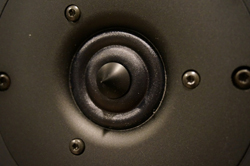
Triad designs everything they make to be used with a subwoofer of some sort. Their philosophy behind this is that it removes many of the placement issues in relation to bass for the main speakers, and it makes them more efficient to drive by removing those larger woofers. This gives you greater efficiency in the speakers that then results in greater dynamics. It also allows you to place the subwoofer in the area of your room with the most even bass response, which often isn’t the same location that provides the speakers with their best soundstage and imaging. This two-piece approach helps with both design and sound quality, and is the same all the way up and down their lines.
The subwoofer they sent along is the Silver In Room model, which houses a 12″ woofer inside of a sealed cabinet. Somewhat surprisingly it is a passive model with an external 600W BASH amplifier with integrated parametric EQ, the RackAmp 600 DSP, that can be mounted with the rest of your components. This is housed inside a 1U tall unit that is easy to slide into your rack and then run speaker wire to your subwoofer, which doesn’t need to be located near a power outlet. The remote has adjustments for modes and levels, which will automatically reset the next time the system is powered on. This way you or your family can crank up the bass as loud as they like for a movie and the next time you power on the system, you won’t be unexpectedly blown away.

The Triad Gold monitors were placed on Sanus Ultimate Foundation stands in the same location I keep my Mythos STS speakers. This put the tweeters almost perfectly at my ear level when in my listening position. The subwoofer was connected to the subwoofer pre-out on my Marantz AV7005 processor and after the EQ was setup using RoomEQ Wizard and a microphone, Audyssey MultEQ XT was run again to make sure everything was configured correctly.
The Triad Gold Monitors and Silver Subwoofer In Use
Triad makes a big deal about how dynamic their speakers are, and I certainly was going to see how accurate they were about those claims. Throwing on Tigerlily from Natalie Merchant and skipping ahead to “Carnival”, I had an immediate reaction to the bass that was there. I know I’ve listened to the track countless times in my life, but pushing the volume more and more there was a bass kick just kept demanding my attention, but it also didn’t dominate the music. Natalie Merchant’s voice is very clean and clear, as the powerful bass did not obscure it and the other instruments. The Silver subwoofer blended in with the Gold monitors effortlessly, bringing the lower octaves of that bass out without making its physical presence known. The seamless integration between the two components was well done, and the EQ on the subwoofer kept the bass tight and helped tame the bass modes in my listening room.
As effective as they are with bringing to life the power of a bass drum, they were equally at home with stringed instruments and more mellow tones. The guitar that Dylan picks away at during Shelter from the Storm comes to life on the best speakers, and it did so with the Triads. It is quite easy to distinguish him moving from the strings to the pick guard on his guitar, so the small gentle sigh into the microphone during the song. For better or worse, you can hear the irregularities of Dylan’s voice and singing come across loud and true on the Gold monitors.
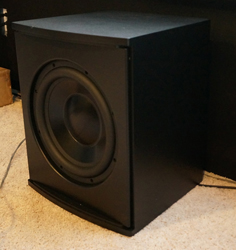
What the Triad’s really bring to life is Hoppípolla from Sigur Ros. While listening to this the music continues to grow and swell, until everything in front of you is overwhelmed with sound. Like a wave that starts low and only grows as it picks up steam headed towards the shore, the Triad’s add more instruments and singers to the music as it took over everything I could see in front of me. My Mythos STS floorstanders can’t produce the same sense of scale in comparison to the Triads. I spent many years stuck with the mistaken idea that small speakers mean small images, but anyone with that thought will be proven wrong by the Triads.
I even moved the Triads onto a second system, using an Anthem Integrated 225 amplifier and no subwoofer for a bit. Sitting less than 6′ away from them they continued to throw out a huge image. The only complaint I had is that the Triads often seemed to favor huge soundstages over perfectly precise ones. Listening to Let It Be, Paul McCartney and his piano seemed to be in a huge, arena sized space and not a small, intimate recording studio. Perhaps it is a mental trick, with my mind associating the dynamics of the Triad for a rock concert, much as our brain is tricked by the 24p cadence of film. Everything from the Triads was big and bold. It was also powerful, detailed, and incredibly crisp and clear, but with a bit of boldness thrown on top.
Used for films, the Triads filled in for the role very well. On my go-to impact scene, the mid-air plane crash in Fight Club, the Gold Monitors were able to go from quiet to a sudden impact with huge swings in SPL but no sign of compression or faltering. The subwoofer ably filled in the lower octaves of scene, helping to bring across the impact of two jets in mid-air. Another mid-air plane crash scene, this one from the opening of The Dark Knight Rises, again came across terrifyingly clear. The sound of the plane being ripped in half exploded into the room and could be felt in your body.
My favorite audio Blu-ray, Dave Matthews Live at Radio City, was remarkably clear. Using the 2.0 mix to be certain to only hear the Triad speakers, the intricate guitar work from Matthews and Tim Reynolds was remarkable. The timbre of the guitar strings was accurate, with that bit of metallic sheen but not a harsh, grating sound. The Triad’s continued to throw that impressive soundstage, here capturing the feeling of Radio City Music Hall and the huge amount of air that the musicians have to fill. With films and concert videos the Triads shined the most, with their incredible dynamics making those feel more real than you can usually experience at home.
The Triad Gold Monitors and Silver Subwoofer On The Bench
All tests were performed in the middle of my listening room on 30″ stands, putting the center almost perfectly between the ceiling and floor. The microphone was placed 1m away and test tones were fed through a Marantz AV7005 and then a Halo A31 amplifier to the Triad speakers.
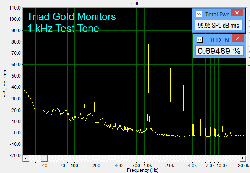
With a 1 kHz test tone at 100 dB, we saw 0.7% THD+N. The 2nd harmonic was over 40dB down from the primary, and all harmonics beyond the 3rd were well below 70dB under the test tone.
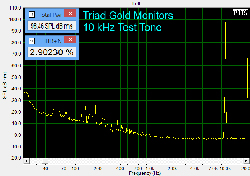
With the 10 kHz tone, the 2nd harmonic was less than 30 dB below the primary tone. Our output here is 98.5 dB for the primary, and the THD+N rises up to 2.90%.
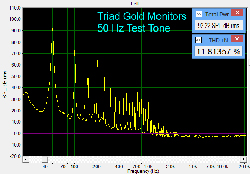
Triad designs all their speakers to be used with a subwoofer for the lower octaves, but I still tested it out to see what it could do. It did manage to get 92 dB on a 50 Hz tone, but with 11.8% THD+N. Triad doesn’t design the Gold to play that low, and you can see that in the data.
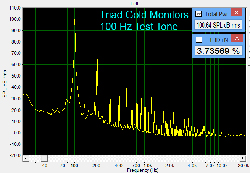
At 100 Hz, above the subwoofer crossover point, we can easily hit 100 dB and distortion drops down to 3.74% THD+N.
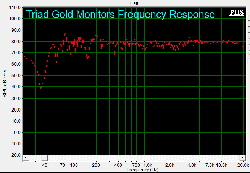
Measuring the Frequency Response, we see that it is really quite flat until a gentle roll-off starting around 17 kHz, at the edge of our hearing. If I switch from log (graph shown above ) to linear (graph shown below) scaling, it is easier to see how flat the overall response is.
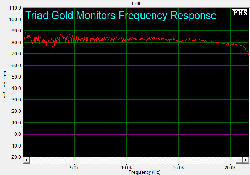
Most people won’t play music at sustained 100 dB levels, but if you want to, the Triad’s didn’t have an issue keeping up.
Conclusions about the Triad Gold Monitors and Silver Subwoofer
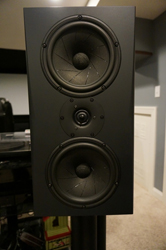
Summing up the Triads in a single word, I would have to go with big. Big soundstage. Big dynamics. Big image. Looking at them you might not think they’re that big, or distinct, or anything other than a generic box speaker, but plug them in and you’ll forget all about appearances. Musical movements rose and fell in towering crescendos with the Triad’s, but never fell apart from their massive size. Movies attacked the senses and impacts on screen were felt in your chest, begging to be turned up higher.
Even after all of that, I still can’t get past that initial Natalie Merchant track, the incredible control the Triad’s had over that bass line, and the way another background instrument came to life that I hadn’t heard before. It was a simple thing, but it made the music so much more tangible and real, to get that bass note right while not covering up the other instruments, that it is what I’ll remember most about the Triads after they leave my possession. They took one of my favorite albums and made it more real that it had been before, and that’s the experience we all want when we listen to something.


